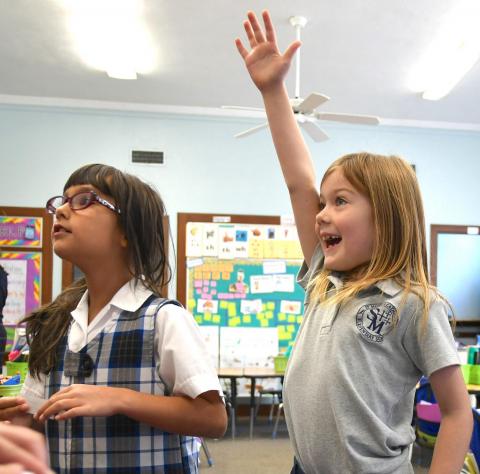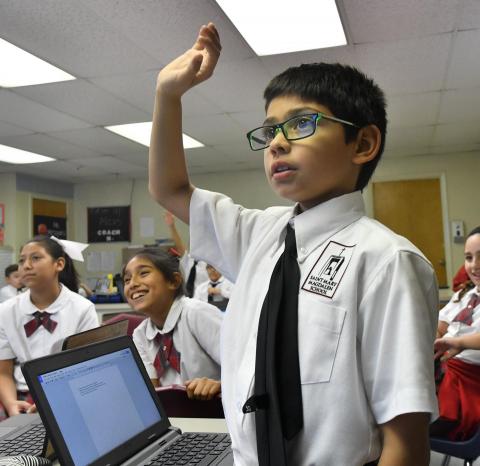7 Strengths of Super Readers Series // Confidence + Courage

Confidence: Thinking independently and expressing ideas with assurance

"I can't read." Perhaps you've heard a child utter these exact words or a similar statement. When the child is three, we can reassure them that they have plenty of time to learn, not to worry, and keep on enjoying being read to and exploring books. When the child is in fourth grade and falling further behind each day, we can see and feel the emotional toll, and the urgency to help them become a strong reader–a super reader–is overwhelming. On the bright side, both children have the potential to become super readers when we create a learning environment that offers countless and consistent opportunities for them to build confidence. As for the two children, the joyful news is that both became confident readers when they had substantial opportunities to practice reading, which improved their skills and confidence!
From educational psychology, we know that motivation is essentially a function of confidence and relevance. If students expect success and they value the activity, they will be motivated to participate and, if one of those elements is missing, motivation will suffer. The problem is not that kids lack the skills or do not value reading as a practice, they simply lack confidence in their ability to be successful at it.

Kylene Beers (2003) writes about three types of confidence in When Kids Can't Read: What Teachers Can Do: cognitive, social and emotional, and stamina and enjoyment. When students embody these three types of confidence, they can improve their literacy achievement and, perhaps even more importantly, develop a positive reader identity. Rather than only focusing on teaching only the skills and strategies that are key to developing as readers, we need to emphasize confidence in our classrooms and appreciate the impact this has on student identity and literacy learning.
So how do we promote confidence inside and outside of school? Socially and culturally relevant literature! Students often lack access to texts that they value or choose. When children read books that they choose about characters who are similar to them and manage to overcome challenges and obstacles, they are encouraged and believe that if the character was able to prevail, so can I! Biographies can be ideal for showing how people have become powerful, often in the face of obstacles and overwhelming challenges.
As texts are being read in class, students should be encouraged to speak and listen to their peers–to use their voices and honor the voices of their classmates. We emphasize the importance of questioning, sharing alternative points of view, and asking open-ended questions. As parents and teachers, we can then ask students to elaborate on their ideas, encourage them to dig deeper into a topic, welcome challenges and be confident in their responses. We can also celebrate their ability to listen, especially during discussions and collaborative activities.

To boost confidence in school, children can create superheroes or engage in close reading. At home, families can promote confidence by offering children ample time and space to practice confidence - especially with questions such as:
1. How do you think we should read tonight?
2. How would you have handled that situation differently?
3. I need your help. How might we solve this problem?
Families can also establish routines. Each strength discussed so far (belonging, curiosity, friendship, and kindness) is critical to helping all children become super readers.
10 Family Routines to Promote Confidence
1. Ask your child about his or her opinions.
2. Give your child time to form opinions.
3. Let your child lead a family dinner or road trip conversation.
4. Allow your child to share the books they are reading.
5. Ask your children for help when solving problems.
6. Talk to your children about how they would change the world.
7. Have family members write why they are proud of themselves.
8. Build children's confidence by allowing time for reading each day and encouraging re-reading.
9. Write notes of praise to your children.
10. Rehearse with your children before performances or exams.

Courage: Having the strength to do something you know is right, even though it may be difficult
Becoming courageous often starts with risk-taking. Deciding to act can transform an individual's life from "being" to "becoming". Courage is critical for change and growth and becoming a super reader requires courage!

What is the best way to expose children to examples of characters being courageous? Literature, of course! However, rather than labeling a character or book as courageous, we can go one step further and consider the type of courage demonstrated by a character or celebrated in a text (across genres). For example, was courage exemplified by standing up for something the character believed in? Was the book about fighting for a cause or taking a risk? As students read through books, they can categorize them based on the type of courage. They can also talk to one another about which books spoke to them or why they chose to categorize the books in a particular way. Books about courage are also ideal for rich discussion and giving students opportunities to jump into the text and make meaningful connections.
Just as we want our students to be "super readers," we want to highlight superheroes in everyday life – people who demonstrated courage under extremely difficult times, such as the Holocaust. One example of extreme courage can be found in The Courage to Care, a book about Max Rothschild during the Holocaust. There are many examples of characters being courageous, from harrowing experiences like the Holocaust or moments during the Civil Rights Movement, that can show students how people gathered up their courage to make monumental changes that impacted the world.

We encourage teachers to provide opportunities for students to talk in a polyvocal classroom. In particular, we focus on four types of talk: whole-class discussion, small group discussion, formal debate, and student presentations. In a polyvocal classroom students take risks, they share their bold ideas, they listen intently to one another, and they are supported by a teacher who is a great listener, facilitator, critical questioner and, above all, a champion for student voice. When students are able to bring their own ideas to the literature they read, they are more thoughtful and engaged as readers and this increases reading volume, reading stamina, fluency, and critical comprehension.
We conclude by exploring ways to use technology and to promote courage at home. Families can develop their own definition of courage and when they have witnessed this type of courage, how it might differ from other people's definitions of courage, or how their definition of courage fits within their own culture and life experiences. We offer 10 routines for families who want to promote courage in the home.
10 Family Routines to Promote Courage
1. Support your child when he or she stands up for a big idea.
2. Point out examples of strong leadership and courage in your town.
3. Identify and discuss courageous characters in the books you read.
4. Encourage your child when she or he takes risks with reading.
5. Discuss the moments in your life when you needed courage.
6. Talk to your child about facing fears in sports, and music.
7. Make a family goal to do something that you are afraid of daily
8. Redefine success to focus on courage and effort (as opposed to outcomes)
9. Seek out opportunities to develop public speaking
10. Create spaces for performance in your home
Happy Reading,
Ernest and Jodene
